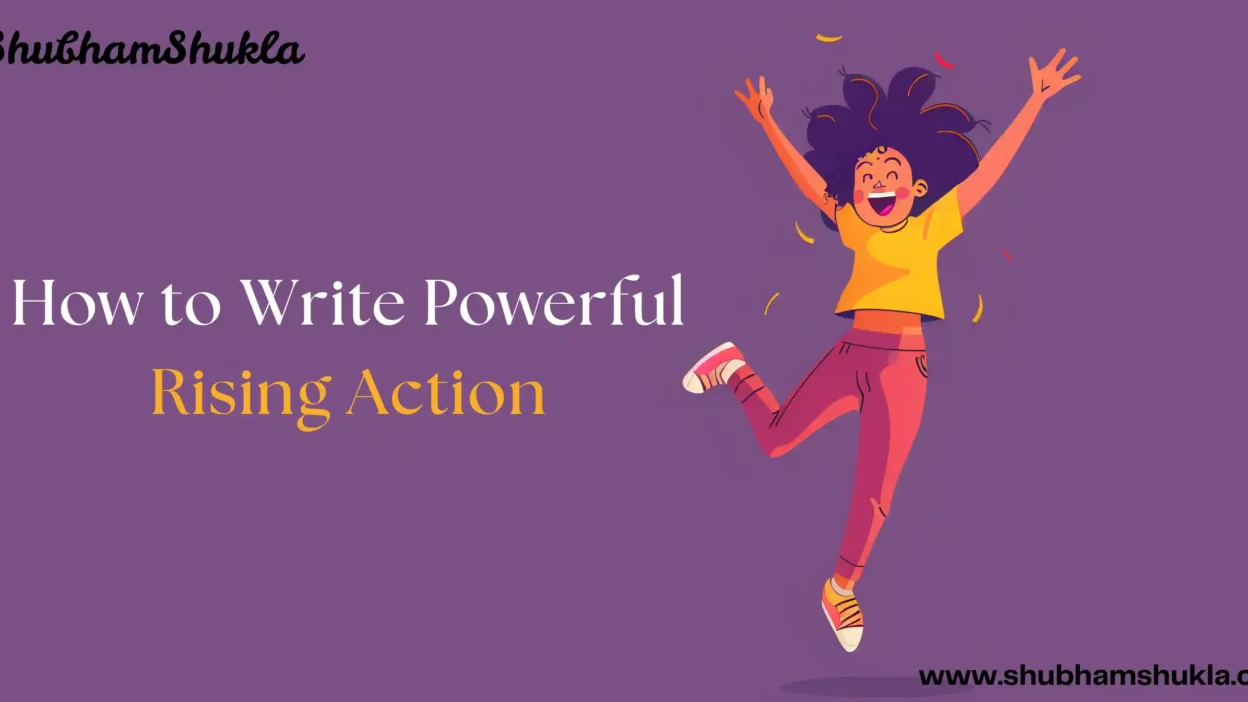There’s a moment in every story where things really start to cook. The tension builds, the stakes rise, and suddenly—boom—you’re flipping pages like your life depends on it. That, my friend, is the magic of rising action. If you’re wondering how to write rising action that actually keeps readers hooked (without getting lost in the weeds), you’re in the right place.
Let’s sit down with a hot cup of coffee and chat like two storytellers trying to figure this thing out together.
You may also like: How to Write a Character Backstory That Actually Matters
So, What Is Rising Action, Really?
Rising action is the middle of your story—the meat of the sandwich between your setup and your big finale. It’s not just “stuff happening.” It’s meaningful stuff happening. Every scene, every twist, every choice should move your characters toward the climax while making things harder, not easier.
Think of Katniss volunteering in The Hunger Games. That’s the inciting incident. But the rising action? It’s everything that happens in the arena—alliances, betrayals, moral choices, and desperate moments—that lead her to the final showdown. Without all that, the climax wouldn’t hit nearly as hard.
If you’re learning how to write rising action, start by asking yourself: What’s the central conflict? How can I make things more complicated, more dangerous, or more emotionally intense with each chapter?
The Key Ingredients of Great Rising Action
Here’s a quick recipe for strong rising action:
- Conflict: Not just physical, but emotional and internal too.
- Stakes: What does the character stand to lose—or gain?
- Escalation: Each scene builds on the last, raising tension.
- Choices: Characters must make tough decisions that reveal who they are.
Let’s say your protagonist is investigating a murder in a small town. Rising action doesn’t mean clue-drop after clue-drop. Maybe her best friend becomes a suspect.
Maybe she starts receiving anonymous threats. Maybe the person helping her turns out to be lying. That’s how you build tension—by making the path harder and riskier.
You may also read: MBTI Characters: Unlocking the Personality Puzzle in Fiction
Step-by-Step: How to Write Rising Action
If you’re staring at a blank page or a saggy middle, here’s a step-by-step approach that can help:
1. Start with the central conflict.
What’s the main thing your protagonist wants? What’s stopping them?
2. Layer in obstacles.
Not just big explosions or fight scenes—but emotional walls, miscommunication, setbacks, secrets.
3. Raise the stakes gradually.
A good rule: each new scene should complicate the goal. Think of rising action like climbing a mountain—the higher you go, the thinner the air and the harder the climb.
4. Foreshadow the climax.
Subtly hint at what’s coming. It builds anticipation and payoff.
5. Let characters evolve.
This is where your character arc really takes shape. They fail, they learn, they change.
One great example? Frodo in The Lord of the Rings. The journey to Mordor is the rising action—filled with conflict, danger, betrayal, temptation. And each obstacle chips away at who he was and shapes who he becomes.
You may also read: The Power of Three: Writing with 3 Main Characters That Truly Shine
In My Own Experience, I Found That…
…rising action works best when I lean into character vulnerability. I used to rush through the middle, trying to hit plot points like checkboxes. But something always felt off.
Then one day, I rewrote a scene where my protagonist had to face an ugly truth about herself—not just fight a villain. Suddenly the story clicked.
It wasn’t just “things happening.” It was her struggling, evolving, breaking down and building back up. That’s when I realized: the best rising action isn’t about external tension alone—it’s about what’s going on inside your characters when things start falling apart.
So, if you’re ever stuck, go deeper. What’s your character afraid of? What truth are they avoiding? That’s where the most powerful rising action lives.
You may also like: Villain vs Antagonist: Why Understanding the Difference Can Level Up Your Storytelling
Common Pitfalls (And How to Dodge Them)
We all hit bumps in the middle. Here are a few common traps—and how to avoid them:
- Flat pacing: If every scene has the same tension level, readers get bored. Mix it up—quiet moments can still carry weight if they deepen stakes.
- Convenient victories: Don’t let your protagonist win too easily. Struggle makes triumph meaningful.
- Unrelated subplots: Keep your subplots connected to the main arc. If it doesn’t tie back to your protagonist’s goal, cut or refocus it.
Remember: rising action should feel like a pressure cooker. You’re tightening the lid, slowly turning up the heat… until the lid finally blows off in the climax.
Fiction Favorites: Rising Action That Nails It
Let’s look at a few examples where rising action truly shines:
- The Martian by Andy Weir: Every chapter brings a new problem (and solution) as Mark Watney fights to survive. The tension never drops.
- Gone Girl by Gillian Flynn: The rising action is a masterclass in shifting reader perspective. Just when you think you know what’s going on—bam, the story flips.
- To Kill a Mockingbird by Harper Lee: The quiet escalation—from Scout’s childhood to the courtroom drama—is a subtle but powerful example of emotional rising action.
Use stories like these as study guides. Ask yourself why the tension works. Then see how you can adapt similar patterns in your own work.
You may also like: Character Arc: How Great Stories Make Characters (and Readers) Evolve
Wrapping Up: You’ve Got This
Learning how to write rising action is one of the most important skills a storyteller can develop. It’s where your plot thickens, your characters shine, and your readers get hooked for good.
So don’t be afraid of the messy middle. Embrace the chaos, the struggle, the chance to make your story unforgettable. Whether you’re outlining your first novel or polishing a work-in-progress, trust the process.
The more pressure you apply, the more satisfying the release.And if you’re ever in doubt? Just remember: rising action isn’t about doing more. It’s about making it matter more.
FAQ: How to Write Rising Action
Q1: Does rising action have to be dramatic or action-packed?
Not at all! It can be internal, emotional, or subtle—so long as the stakes increase and tension builds.
Q2: How long should the rising action be?
It usually spans the entire second act—roughly 50–60% of the story. But let your pacing serve the story, not a formula.
Q3: Can a subplot have its own rising action?
Yes! Well-written subplots mirror or contrast the main arc, and their own rising action can deepen your story’s emotional payoff.
Go back to your character’s goal and what’s at risk. Then throw something in their path that shakes them emotionally or morally. That usually reignites momentum.



